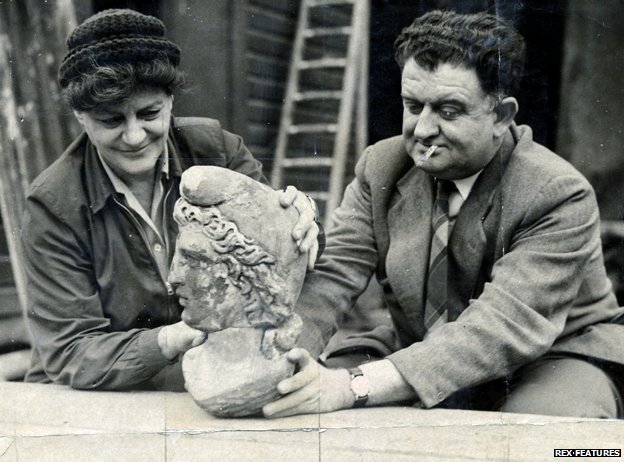 The other day in class I drew on an old example that I’ve used before, but which always turns out to be a useful way to illustrate the commonsense, philosophical idealism that we bring to the way we normally talk and think about identity — a commonsense approach that might be worthwhile rethinking when we move from simply proclaiming our supposed identity to studying how it is that we accomplish the work of identification in the first place. Continue reading “My Left Foot”
The other day in class I drew on an old example that I’ve used before, but which always turns out to be a useful way to illustrate the commonsense, philosophical idealism that we bring to the way we normally talk and think about identity — a commonsense approach that might be worthwhile rethinking when we move from simply proclaiming our supposed identity to studying how it is that we accomplish the work of identification in the first place. Continue reading “My Left Foot”
“You keep using that word. I do not think it means what you think it means”
 Sometimes the spam comments on the site are truly inspiring.
Sometimes the spam comments on the site are truly inspiring.
Why It’s Not “Victor’s Secret”

As I often point out to my Feminist Theory students, there’s a reason why Victoria has a secret, but Victor doesn’t. In other words, there’s a reason why women have “lingerie” and men have “underwear.” Although we’re clearly talking about undergarments, the words here matter. As might be obvious, the former term has a sexual intent behind it that the latter simply doesn’t. One could argue that what the model is wearing in the above photo has sex appeal because the consumer ultimately imagines its removal: lingerie is something you take off, while underwear is something you put on. And yet part of the allure of the lingerie above is that it must also be on to “work” – through the magic of underwire and spandex and every other sort of “suck it in, push em up” technology, the above body is simultaneously a manufactured one that the lingerie makes (a function perhaps desirable only to those who are non-supermodels). And here we come across another interesting double-standard in undergarment function, for I cannot recall hearing of any sort of mainstream line of men’s underwear that has a “tummy control” panel. Continue reading “Why It’s Not “Victor’s Secret””
The Myth of Origins

 – Jacques Derrida, Writing and Difference (1978), p. 285
– Jacques Derrida, Writing and Difference (1978), p. 285
Just Really Old… Or Historical?

BBC News ran a feature this morning entitled “Temple of Mithras: How do you put London’s Roman shrine back together?” about a sixty-year-old excavation of a Roman temple, the remains of which were found when an insurance firm was being built on the site where the third-century shrine once stood. In the span of a couple of weeks back in 1954, a whopping 400,000 people lined up to see the ruins before they were moved and placed on display. Continue reading “Just Really Old… Or Historical?”
“Smile for the Camera”
 I was browsing through the late Raymond Williams’s Marxism and Literature (1977) the other day and came across a passage in the chapter entitled “Signs and Notations” that read as follows:
I was browsing through the late Raymond Williams’s Marxism and Literature (1977) the other day and came across a passage in the chapter entitled “Signs and Notations” that read as follows:
For the ‘sign’ is ‘arbitrary’ only from the position of conscious or unconscious alienation. Its apparent arbitrariness is a form of social distance, itself a form of relationship…. The formal quality of words as ‘signs,’ which was correctly perceived, was rendered as ‘arbitrary’ by a privileged withdrawal from the lived and living relationships which, within any native language … make all formal meanings significant and substantial, in a world of reciprocal reference which moves, as it must, beyond the signs.
There’s a few important points here, I think, worth mulling over — perhaps with regard to the garment workers in the above photo. Continue reading ““Smile for the Camera””
I Smell Something Fishy
 Yes, it’s time for college football; if you work at a US university with a football program and you’re not paying attention to the other cuess — like the pretty sparse attendance on Fridays if Saturday is an away game — then you’ll surely know this by the difficult-to-overlook influx of port-a-potties that arrive midweek, to handle the game day, shall we say, demand.
Yes, it’s time for college football; if you work at a US university with a football program and you’re not paying attention to the other cuess — like the pretty sparse attendance on Fridays if Saturday is an away game — then you’ll surely know this by the difficult-to-overlook influx of port-a-potties that arrive midweek, to handle the game day, shall we say, demand.
At least at my school they’re lined up like dutiful soldiers all around the heart of the old campus, where I happen to have my office. Continue reading “I Smell Something Fishy”
Whose Unity?
 The people of Scotland are voting today to determine whether they should be independent of the United Kingdom or remain within it. (Watch this Guardian video for background). Bill Clinton recently encouraged Scots to remain within the U.K., asserting
The people of Scotland are voting today to determine whether they should be independent of the United Kingdom or remain within it. (Watch this Guardian video for background). Bill Clinton recently encouraged Scots to remain within the U.K., asserting
Unity with maximum self-determination sends a powerful message to a world torn by identity conflicts that it is possible to respect our differences while living and working together. This is the great challenge of our time. The Scots can show us how to meet it.
His sentiment here, calling for respect “while living and working together,” is something that many of us desire. His reference to “unity,” though, becomes another instance of naturalizing a historical construction, much like my post yesterday about attitudes towards texts. The “unity” that he advocates obviously references the current international boundaries of the U.K. and the notion that those within those boundaries form a singular community. Those boundaries, of course, have shifted time and time again. Treating them as sacrosanct where they are now suggests a timelessness that conveniently forgets past shifts. This sentiment is not unique to the U.K. but occurs frequently with references to the territorial integrity of Ukraine, Iraq, Turkey, India, . . ., as if those boundaries were automatic.
I am not interested in entering the debate over the unity of any particular nation-state or undermining that unity. Both separation and unity require significant blood, sweat, and tears. But we should also be mindful of whose interests are served when “territorial integrity” of contemporary nation-states is treated as if it should never be questioned.
“Map of Scotland within the United Kingdom” by Peeperman – This file was derived from: British Isles United Kingdom.svg . Licensed under CC BY-SA 3.0 via Wikimedia Commons.
Residual Assumptions

In a recent email discussion among scholars about general issues of representations and Wendy Doniger’s controversial book (about which I have written on Culture on the Edge and Bulletin for the Study of Religion blog), P. Pratap Kumar, a colleague in South Africa, framed the issue through a clear, though contrived, contrast between the scholar and the devotee. He wrote,
Someone who is raised as a Hindu grows up listening to religious songs at Satsangs and even through Bollywood religious songs (there are plenty of Bollywood religious songs that Hindus listen to with utmost devotion) and never would have known that their Hindu texts contain many erotic statements and not just the singular term Linga. But on the other hand, scholars especially from the outside Hindu tradition (be they western or eastern) begin with Sanskrit language and then reading the highly specialised texts where they find statements that devout Hindus would have never heard of. From scholar’s reading, there are indeed very detailed erotic references in many Hindu texts, . . .
We as scholars have to talk about these things because these matters are there in the texts from the Rig Veda to the epics in plenty of places. It is hard to fault a western scholar or any non-Hindu scholar for pointing these out and translating them for what they are.
An Agonistic Affair
 If identification is an agonistic affair — in which social actors continually define and redefine Self and Other while wrestling over competing interests, ranks, and domains — then negotiating what counts as a legitimate place for a date (especially when one party forgot it was Valentines Day and failed to make a reservation somewhere nice) might be as good a place as any other to try to see what’s going on when we try to ascribe an identity.
If identification is an agonistic affair — in which social actors continually define and redefine Self and Other while wrestling over competing interests, ranks, and domains — then negotiating what counts as a legitimate place for a date (especially when one party forgot it was Valentines Day and failed to make a reservation somewhere nice) might be as good a place as any other to try to see what’s going on when we try to ascribe an identity.
